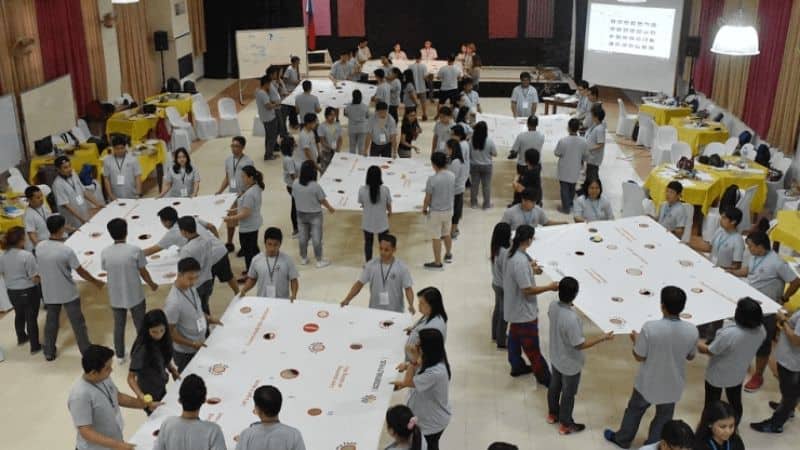Every manager and supervisor must learn how to build a successful team. Doing so is both strategic and practical. A successful team accomplishes goals and delivers results.
Building a team is a deliberate effort. It is a mistake to think that a one-day team-building event can do the magic. What a team-building experience can do is speed up growth. However, it has been my experience that many leaders do not pay attention to what happens in team building.
To help you realize the importance of the role of managers as team-building facilitators, I came up with a fictional story to show what you can do in 90 days.
The 90-Day Team Building Project
A seasoned manager Antonio is assigned to lead an all-Filipino team at TechNovate Inc., a leading tech firm. The team, although brimming with potential, is struggling.
Antonio is determined to turn this group from a dysfunctional unit into a high-performing team within 90 days. With the guidance of his mentor Romeo, an experienced leader familiar with both Filipino culture and Lencioni’s model, Antonio embarks on a transformative journey.

Build Trust
In his first week, Antonio calls Romeo for advice. Romeo reiterates the importance of the first step of Lencioni’s model – building trust. He reminds Antonio of the Filipino value of “tiwala,” or trust, and advises him to leverage “pakikipagkapwa-tao” and “pakikisama” – treating each other as equals and maintaining smooth interpersonal relationships.
“Antonio,” Romeo begins, “Filipinos value ‘tiwala’. Remember, help your team see each other as equals and treat each other with respect. Start by being open about your own challenges and mistakes. Show them that making mistakes is part of the journey.”
Taking Romeo’s advice to heart, Antonio starts by sharing his experiences in the team’s first meeting, discussing his mistakes and lessons learned. This move reduces the team’s fear of judgment and fosters a learning culture.
In the subsequent weeks, Antonio organizes team-building activities, understanding the Filipino love for socializing and camaraderie. These activities encourage members to share personal experiences, fostering openness and mutual understanding.
Romeo also advises Antonio to encourage “bayanihan,” a Filipino practice of helping each other, “Encourage them to extend help without waiting to be asked. This not only strengthens ‘Bayanihan,’ but also builds trust.”
As Antonio integrates these practices into the team, members begin to feel comfortable sharing their struggles and seeking help.
By the end of the third week, Antonio notices a positive shift. The hesitancy among team members is receding, replaced by a growing camaraderie.
Trust is slowly but steadily building, setting the foundation for the next stage of Antonio’s 90-day transformation journey: encouraging healthy conflict.
Encourage Healthy Conflict
As trust develops within the team, Antonio recognizes it’s time to address the second dysfunction – the fear of conflict. To his surprise, the team avoids disagreements to maintain surface-level harmony.
However, Antonio, with Romeo’s guidance, understands the value of healthy conflict in reaching innovative solutions and making informed decisions.
Romeo suggests, “The concept of ‘pakikisama’ or getting along with others is deeply ingrained in Filipino culture. But sometimes, it can lead to avoidance of conflict. Encourage ‘tampuhan,’ which is a temporary, petty conflict, instead of letting resentment build up.”
In the following week, Antonio uses Romeo’s advice in a team meeting to discuss a contentious issue. Encouraging them to voice their opinions, Antonio reminds the team that disagreements are part of a healthy process to arrive at the best solutions.
“Remember,” Antonio begins, “just as ‘pakikisama’ is important, so is voicing your opinions. ‘Tampuhan’ might seem petty, but it’s better to clear misunderstandings immediately instead of letting resentment build.”
He also underscores the importance of separating ideas from individuals, ensuring that debates focus on problem-solving, not personal attacks. To encourage this, Antonio introduces structured brainstorming sessions. In these sessions, everyone has an opportunity to voice their ideas and concerns, and conflicts around ideas are encouraged.
In addition, Antonio brings in guest speakers who are seasoned Filipino professionals to share experiences on how healthy conflicts led to better decisions and innovation in their respective teams.
By the end of the sixth week, Antonio sees progress. Team meetings are livelier, filled with passionate discussions. Members debate and disagree, but without any residual animosity. Instead, there’s a growing sense of respect and appreciation for diverse perspectives. With the foundation of trust and the practice of healthy conflict in place, Antonio prepares for the next phase of the journey – fostering commitment.
Foster Commitment
Moving on to the third stage, Antonio finds himself facing a team that, while increasingly open and engaged in debate, often hesitates when it comes to committing to decisions.
The fear of failure and the uncertainty of outcomes tend to overshadow their drive for success. Seeking advice, Antonio turns to Romeo.
Romeo, wise and understanding, advises him, “Filipinos value consensus. Make sure everyone feels their voice is heard before a decision is made. But equally important is courage. Encourage them to commit to their decisions without fear of failure.”
Encouraged by Romeo’s words, Antonio starts by involving every team member in the decision-making process. He ensures that meetings don’t conclude without a clear course of action and that everyone understands their role in the decisions taken.
He reinforces that while their ideas are valuable, it’s the team’s overall decision that matters.
In one of the team meetings, Antonio shares, “We all have courage within us. Don’t be afraid to make mistakes. As long as we learn and grow, we’re moving in the right direction.”
To enhance commitment, Antonio introduces a commitment board in the team’s workspace. Every time a decision is made, it is written on the board, reinforcing the team’s responsibility towards it. Regular follow-up meetings are scheduled to track the progress and make necessary adjustments.
By the end of the ninth week, Antonio notices a significant change. The team, once hesitant, now takes ownership of their decisions and responsibilities. A sense of commitment, driven by their shared decisions and clear understanding of their roles, starts to envelop the team.
With this newfound commitment, Antonio gears up for the next stage – promoting accountability.
Promote Accountability
With a sense of commitment starting to permeate the team, Antonio realizes it’s time to address the fourth dysfunction – avoidance of accountability. Noticing a reluctance among team members to call out peers on unproductive behaviors, Antonio consults Romeo for guidance.
Romeo advises, “Filipinos are known for their ‘hiya,’ or sense of shame. It may make them avoid confrontation, even when necessary. Counter this by promoting responsibility. Show them that accountability is not about shaming, but about helping each other grow.”
Taking Romeo’s advice, Antonio introduces regular performance reviews, where team members assess their own and each other’s performance. Emphasizing that this process is not about criticizing but about identifying areas for improvement, Antonio helps them understand that accountability is a shared responsibility.
During one of these sessions, Antonio shares, “Remember, ‘pananagutan’ is not just about doing our own tasks well but also about helping each other perform better. Let’s view this as an opportunity to help each other grow.”
To facilitate this, Antonio encourages team members to set personal performance goals and share them with the team. They also discuss potential challenges they might face in achieving these goals and how the team can support each other to overcome these.
Moreover, Antonio establishes clear lines of communication where team members can share concerns and feedback, fostering an environment of open dialogue and shared responsibility.
By the end of the twelfth week, Antonio is satisfied with the progress. The team, once hesitant to address unproductive behaviors, now understands the value of mutual accountability.
There is a noticeable improvement in performance, and a culture of accountability begins to solidify. With the team steadily progressing, Antonio braces himself for the final step in this transformative journey – focusing on collective results.
Focus on Collective Results
Finally, Antonio is ready to address the last dysfunction – inattention to results. Despite improvements in trust, conflict management, commitment, and accountability, Antonio observes some team members still focus more on personal achievements than on collective team results.
Seeking Romeo’s wisdom, Antonio shares his observations. Understanding, Romeo replies, “Remember, ‘bayanihan’ is not just about helping each other; it also signifies a community working together to achieve a common goal. Reiterate the importance of the collective over the individual.”
Following Romeo’s advice, Antonio revisits the team’s shared goals and objectives, emphasizing the importance of collective results.
He introduces the concept of “Kapit-Bisig,” a Filipino value symbolizing unity and collective effort, explaining how each member’s work contributes to the team’s overall goal.
During a team meeting, Antonio shares, “Just as we hold hands, or ‘kapit-bisig,’ we must also work together to achieve our common goals. Our individual successes are important, but our collective results define us as a team.”
To emphasize this, Antonio implements a reward system that celebrates team achievements. Each accomplishment of the team’s goal is recognized and celebrated, reinforcing the importance of collective results.
He also ensures that team goals are visibly displayed in the workspace, serving as a constant reminder of what they are striving for together.
By the end of the 14th week, Antonio sees a change. Team members, once primarily concerned with individual success, now understand the value of their collective results. A sense of unity and shared purpose fills the team, signaling the successful transformation from a dysfunctional group into a high-performing team.
As Antonio looks back at the past 90 days, he feels a sense of accomplishment. With the support of his mentor Romeo and the resilience of his team, he has successfully integrated Lencioni’s model with traditional Filipino values, transforming his team into a functional, cohesive unit. The journey was challenging, but the reward of seeing his team perform at their best was worth every step.
Build a Successful Team
The journey Antonio embarked on is a testament to the power of trust, healthy conflict, commitment, accountability, and collective results in transforming a team.
As a leader, whether you’re handling a new team or aiming to improve an existing one, you can employ these steps to help you build a successful team. Here’s a summary of what you can do:
- Build Trust: Encourage open communication, share vulnerabilities, and foster a culture of mutual respect and learning. In Antonio’s journey, this involved embracing the Filipino value of ‘pakikipagkapwa-tao’ and ‘pakikisama.’
- Encourage Healthy Conflict: Foster an environment where differing opinions are welcomed and debated. This can lead to more innovative and informed decisions. Antonio did this by encouraging ‘tampuhan,’ or temporary conflicts, to clear up misunderstandings.
- Foster Commitment: Ensure everyone has a voice in decision-making and understand their roles in these decisions. Antonio promoted ‘tapang’ or courage, to help team members commit without fear of failure.
- Promote Accountability: Establish regular performance reviews and encourage team members to hold each other accountable. This promotes a sense of shared responsibility and continuous growth. Antonio introduced ‘pananagutan’ or responsibility, helping team members see accountability as an opportunity for growth.
- Focus on Collective Results: Reiterate the importance of achieving team goals over individual successes. This creates a unified team working towards a shared objective. Antonio emphasized ‘Kapit-Bisig,’ or unity, and introduced a reward system that celebrates team achievements.
The journey to build a successful team is a process. It requires time, patience, and consistent effort. Every step you take, no matter how small, moves you a bit further along the path. Be patient and persistent, and you too can transform your team into a highly efficient and cohesive unit, just like Antonio did.
Good luck on your journey to building a successful team!


